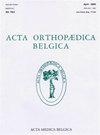Outcome of lateral retinacular nerve transection combined with release for recalcitrant iliotibial band friction syndrome.
IF 0.6
4区 医学
Q4 ORTHOPEDICS
引用次数: 0
Abstract
In this retrospective study, a technique consisting in neurolysis of the lateral retinacular nerve combined with a partial release through elliptic excision of the iliotibial band (ITB) is evaluated for efficacy in recalcitrant ITB friction syndrome and compared with results from other techniques reported in literature. From April 2014 to December 2017, 21 patients suffering from recalcitrant ITB friction syndrome were surgically treated with the aforementioned technique. 15 patients (15 knees) were available for a written retrospective reassessment after completion of a follow-up period of at least 12 months. Residual pain was scored using the Visual Analogue Scale (VAS). The functional outcome was evaluated by two patient reported outcome measurement scales (PROMs), the Lysholm and the International Knee Documentation Committee (IKDC) score. Return to sport was analysed by duration of the inactivity period as well as by the Tegner score. Overall satisfaction was evaluated using a modified Boyden scale. At final follow-up of one year, the performed intervention resulted in a pain reduction (VAS 4.2 (1-8) to 1.4 (0-6)) and improved knee function (Lysholm 59.53 to 87.73, IKDC 75) with return to sport (Tegner 4.3 to 5.4) after a median of 23.8 weeks (6 to 52). Twelve patients reported good or excellent results (80%) at final follow-up, and 12 patients (80%) would undergo surgery again, if necessary. The treatment of recalcitrant ITB friction syndrome by combining neurectomy of the lateral retinacular nerve with elliptic excision of the ITB resulted in good to excellent results in 80% of treated cases with return to sport in 93%.外侧支持带神经切断联合松解治疗顽固性髂胫束摩擦综合征的疗效。
在这项回顾性研究中,评估了一种包括外侧支持带神经松解结合髂胫束椭圆形切除术(ITB)部分松解的技术对顽固性ITB摩擦综合征的疗效,并与文献中报道的其他技术的结果进行了比较。从2014年4月到2017年12月,21名患有顽固性ITB摩擦综合征的患者接受了上述技术的手术治疗。15名患者(15膝)在完成至少12个月的随访期后可进行书面回顾性重新评估。使用视觉模拟量表(VAS)对残余疼痛进行评分。通过两种患者报告的结果测量量表(PROM)、Lysholm和国际膝关节文献委员会(IKDC)评分来评估功能结果。根据不活动期的持续时间和Tegner评分对重返体育运动进行了分析。总体满意度采用改良的博伊登量表进行评估。在一年的最后一次随访中,所进行的干预导致疼痛减轻(VAS 4.2(1-8)至1.4(0-6)),膝关节功能改善(Lysholm 59.53至87.73,IKDC 75),并在中位23.8周(6至52周)后恢复运动(Tegner 4.3至5.4)。12名患者在最后的随访中报告了良好或优秀的结果(80%),12名患者(80%)将在必要时再次接受手术。通过外侧支持带神经切断术和ITB椭圆形切除术联合治疗顽固性ITB摩擦综合征,80%的治疗病例取得了良好至卓越的效果,93%的患者恢复了运动。
本文章由计算机程序翻译,如有差异,请以英文原文为准。
求助全文
约1分钟内获得全文
求助全文
来源期刊

Acta orthopaedica Belgica
医学-整形外科
CiteScore
0.70
自引率
0.00%
发文量
58
审稿时长
4-8 weeks
期刊介绍:
Information not localized
 求助内容:
求助内容: 应助结果提醒方式:
应助结果提醒方式:


